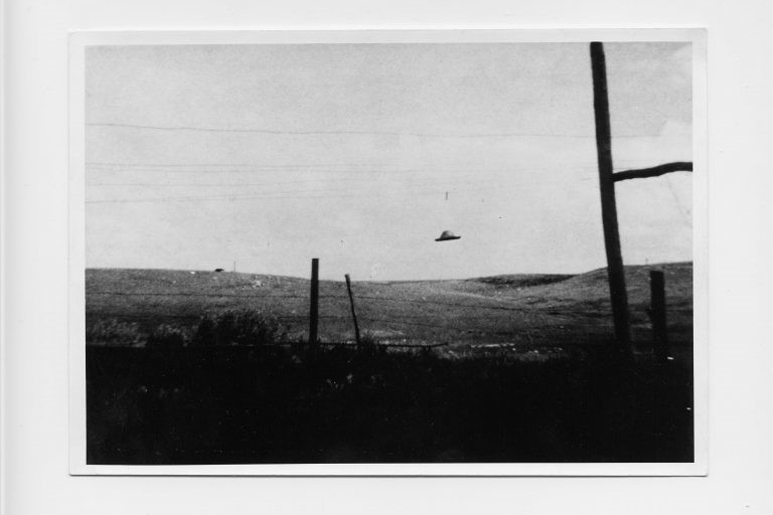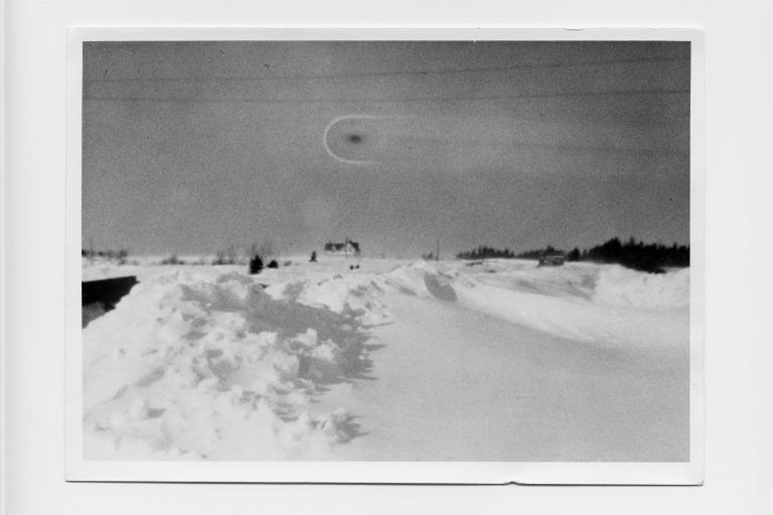In the 1960s, UFO sightings around the world increased exponentially, with many occurring in Canada. One remarkable story was reported concerning a close encounter with a UFO in the wilderness bush of Manitoba. Follow-up stories emerged that the witness had suffered serious illness from his encounter with the UFO.
Although Canadian government files were accumulating many of these reported sightings, it seemed that no apparent ‘scientific’ field investigations were being conducted when ‘physical evidence’ was reported. To add to the UFO frenzy, the U.S. had established “Project Blue Book” in 1952 and had enlisted the aid of Dr. Allen Hynek, a well-known astronomer from Northwestern University, Illionis, to investigate American sightings.
Hynek originally debunked the existence of UFOs. In fact, one of his famous remarks attributed some sightings in a wilderness area as nothing more than an illusion caused by swamp gas. As many of us know, he changed his mind about UFOs and in fact became a strong advocate of the notion that there must be some substance to many of these stories. In fact, he established a ranking of the types of UFO incidents he was investigating: those of the first kind (sightings), those of the second kind (some physical evidence, such as photographs) and encounters of the third kind – actual physical contact which would include abductions (Dr. Hynek served as a consultant on the 1977 film Close Encounters of the Third Kind).
Thus Dr. Patterson decided to establish a core of aerospace scientists to investigate sightings in Canada. I was delighted when he asked me to lead our investigative group. Two of my colleagues, Dr. Stan Townsend and Dr. Ray Measures, agreed to work with me. Interestingly, none of the senior professors at UTIAS wanted to become involved, perhaps for obvious reasons. However, the three of us, being junior Assistant Professors, thought it would be a great learning experience to find out more about this subject, and to collaborate with U.S. scientists such as Dr. Hynek and Dr. James MacDonald.
Dr. MacDonald, noted for his in-depth UFO reports, pleaded with the United Nations and the U.S. Air Force to formally support research on UFOs. Dr. McDonald had served in the U.S. Navy Intelligence section during the war, 1942-45, and was the Director of the Institute of Atmospheric Physics at the University of Arizona. In 1968, he visited UTIAS to review his case for the existence of UFOs. Later, in 1971, we learned of his mysterious death in the Arizona desert.
The Institute also had a working relationship with the Canadian National Research Council in Ottawa which had access to DND sighting reports. Thus, our first task was to visit NRC and review DND files that were not open to the public. I recall that Prof. Barry French accompanied us on that visit because he was intrigued by what the DND might have on file. As soon as we arrived on site, we were asked to sign a non-disclosure agreement that would prevent us from ever disclosing any of the contents of the files we were about to read, subject to severe penalties for non-compliance. We all agreed somewhat reluctantly, since it put us in the position of not being able to talk to our boss, Dr. Patterson, about what we had read. Suffice it to say, even 40 years later, there was a great deal of investigative information that could not be made public since many of the comments made by the interviewers from different government agencies might be subject to legal action. On the other hand, there were some cases with photographic evidence that were termed “unexplainable.”
As a result of this first foray into the world of confidential information, we agreed to inform the ‘Doc,’ our friendly name for Dr. Patterson, that we saw nothing that should dissuade us from following through with our plans, at least for a year, to see what evidence we could accumulate.
Over the next year or so, we were deluged with phone calls about sightings, photographs, and on occasion reports of physical evidence that had to be investigated. Some phone calls resulted in a visit by at least two of the committee members when we felt there was a real opportunity to hear about a ‘high probability’ sighting. At this point, I should mention that we received many reports of individuals ‘communicating’ with aliens, but there was little we could do other than listen politely and move on to other calls.
One day, a call came from an Ontario Provincial Police (OPP) station in Whitby requesting the UTIAS team to come out that night to speak with one of their patrol officers who had seen UFO lights flying parallel to the highway down the length of Lake Ontario. The officer had been so entranced by these lights, as he tracked them along the highway, that he hit an embankment and flipped his car. Dr. Ray Measures and I went out and met the officer, whom we interviewed in a jail cell; not that he had been arrested, but it was the only private space available there at that time. We believed he had seen these lights, and we told his commanding officer that we had also received other calls from people who had seen similar lights flying at high speed over the lake. Later the next day, we found out through our contacts at the Canadian Air Force that it was common practice for fighter aircraft to attempt to penetrate US air space over the lake in joint exercises undertaken by the U.S. and Canada. The lighted aircraft would be visible, and then at a certain point in the exercise, the lights would flash out, giving the impression of the ‘UFO’ vanishing at high speed. After that, we received no more calls from the OPP.
Many photographs were received by our group, but most were fakes, such as the one shown below in Image 1.

Fake UFO hanging from a wire
On other occasions, we received photos that seemed unusual, and that we could not prove were fake, such as the one in Image 2.

Unexplained optical effect or UFO?
One of these images was a Class 2 sighting captured on a coloured slide of a grey elongated object that cast a cloud on the forest trees below, as well as reflecting sunlight off parts of its surface. This slide was submitted to our group by a forester in northern B.C. It was found to be authentic, based on an analysis performed by DND in Ottawa, (prior to the computer age)…..in other words, the slide was clearly and provably undoctored, and the object’s size was consistent with the shadow on the trees…not a photograph of a tossed disc, which we often received as ‘evidence’ of a flying saucer. We might have dismissed this sighting as being an unusual cloud except for the fact that the forester had noted that after a few minutes, the object suddenly flew off and disappeared. This was a ‘sighting’ that we could not explain.
An interesting case that we solved related to what is known in the UFO literature as ‘angel hair.’ We were sent spherical-shaped clumps of metallic strips (about 4 in. in diameter) found in a deserted area of a farmer’s field in northern Ontario. After analyzing the composition of the strips, and based on measurements we made of their individual length and width, it turned out to be aluminum radar chaff. These clumps of radar chaff were dumped during war games between the U.S. and Canada when Canadian fighter aircraft attempted to penetrate U.S. airspace undetected across the lake at night. This was a non-scheduled exercise to test U.S. readiness. Clumping of the chaff occurs when it is stored in canisters in a hangar and becomes damp over time. When the canisters are slit in flight to produce a floating cloud of radar-reflecting chaff, it can fall to earth as clumps. Knowing the strip dimensions apparently allows the calculation of the wavelength of the radar being used – much to the dismay of the U.S. military. We were quickly informed not to publish this data. Consequently, not wanting to antagonize DND, we kept quiet about this information and reported only that the material was aluminum foil, not some alien material. We were never pressed to explain where it came from.
We analyzed many sightings and physical evidence, including, ground circles in remote fields, and we interviewed many people who claimed to have seen a UFO.
Our UFO program was phased out following the publication of a significant UFO report by Dr. Edward Condon. Condon was a well-known and respected physicist from the University of Colorado hired by the USAF Office of Scientific Research to perform a comprehensive review of all sightings logged in their Blue Book files. We visited Condon in Colorado prior to the publication of his findings, to get his assessment on this phenomenon. In the end, his conclusions essentially laid to rest the reality of alien spacecraft visiting earth, based on the data he had at hand, although he had to admit there were several cases that were both credible and unexplainable.
Condon’s report resulted in the closing of Project Blue Book in 1969, as well as our program at UTIAS. However, in 1973, Dr. Hynek formed a Center for UFO Studies (CUFOS) and purchased the UFO files from NICAP when it folded shortly after the Condon report. Hynek died in 1986, but CUFOS still exists today. Occasionally, we hear of Members of Parliament asking the government to release specific UFO files, and to open the books on any classified documents pertaining to UFO reports. Most cases that are classified remain so due to legal and privacy concerns, not because of any attempt to hide information about the reality of UFOs.